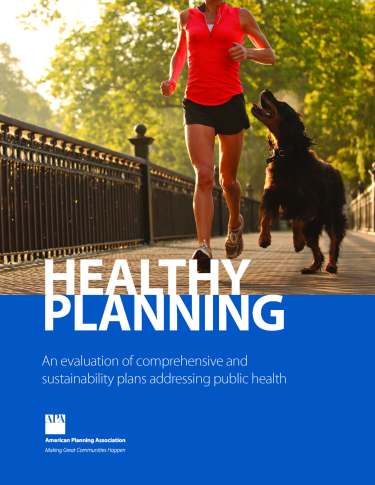 The American Planning Association’s Planning and Community Health Research Center recently released a new publication – Healthy Planning: An Evaluation Of Comprehensive And Sustainability Plans Addressing Public Health. This report provides results from an evaluation of 18 local comprehensive plans and 4 sustainability plans from local governments across the United States that address various public health topics and issue areas in their local level plans. Results highlight the progress of specific localities in addressing public health, but also reveal the slowness of the planning field to fully embrace public health as an important societal issue.
The American Planning Association’s Planning and Community Health Research Center recently released a new publication – Healthy Planning: An Evaluation Of Comprehensive And Sustainability Plans Addressing Public Health. This report provides results from an evaluation of 18 local comprehensive plans and 4 sustainability plans from local governments across the United States that address various public health topics and issue areas in their local level plans. Results highlight the progress of specific localities in addressing public health, but also reveal the slowness of the planning field to fully embrace public health as an important societal issue.
This evaluation is part of a multiphase research study that began in 2010 for the purpose of identifying “local planning responses to important health issues [and examining] how comprehensive and sustainability plans can promote long-term community health.”
The multiphase study commenced with a national survey to identify local governments across the U.S. that are actively planning for public health. According to the survey, only 260 and 51 respondents indicated that their local comprehensive plan or sustainability plan, respectively, contains explicit goals or policies that address public health.
 Not surprisingly, traditional public health topics, like clean water and air, emergency preparedness, and public safety were cited the most. However topics related to chronic disease, social health and equity; and food and nutrition – all high priority public health issue areas – were only addressed by 6.7%, 12.6%, and 8.7% of the identified comprehensive plans, and 4.9%, 35.3%, and 22.2% of identified sustainability plans that explicitly addressed public health.
Not surprisingly, traditional public health topics, like clean water and air, emergency preparedness, and public safety were cited the most. However topics related to chronic disease, social health and equity; and food and nutrition – all high priority public health issue areas – were only addressed by 6.7%, 12.6%, and 8.7% of the identified comprehensive plans, and 4.9%, 35.3%, and 22.2% of identified sustainability plans that explicitly addressed public health.
Based on specific criteria (such as geographic spread, plan adoption date, population, and inclusion of 10 or more health related topics), APA staff and its advisory committee selected a handful of these identified plans for further evaluation. Selected comprehensive plans included Alachua County, FL; Baltimore County, MD; Chino, CA; Washington, DC; Don Ana County, NM; Dubuque, IA; Easton, PA; Fort Worth, TX’ Kings County, CA; Niagara County, NY; North Miami, FL; Omaha, NE; Oneida Nation, WI; Palm Beach County, FL; Raleigh, NC; San Diego City, CA; South Gate, CA; and Trenton, NJ. Selected sustainability plans included San Francisco, CA; Grand Rapids, MI; Philadelphia, PA; and Mansfield, CT.
The APA team developed an evaluation tool to evaluate the extent to which these plans address various components of public health, the overall quality and structure of each plan, and the implementation strategies used to achieve public health goals. Results of the evaluation revealed that overall, the plans made clear connections between planning, the built environment and public health impacts. However, goals and policies related to active living were strongest, while explicit connections to other public health issues, like food and nutrition, social cohesion and mental health, and health and human services were less frequent and not comprehensive. Plans that included a standalone health element tended to have a greater and more comprehensive emphasis on health, than plans that integrated public health throughout. One of the most noticeable weaknesses of the evaluated plans was the “lack of explicit discussion about how the built environment can affect a range of public health factors”. Additionally, public health data was often not utilized to support public health related goals and policies.
The results of this research point to the need to further educate planners about the connections between the built, natural, and social environments, and public health. While planning has its roots in public health, the field has a long way to go before it fully embraces public heath – in all its dimensions. After all, how can a community be truly sustainable without a healthy population?
Cultivating Healthy Places’ founder, Kimberley Hodgson, led the initiation of this multiphase research study, when she was the Manager of APA’s Planning and Community Health Research Center from 2008 to 2011. She currently serves on the advisory committee for this study.
This blog post was originally published on Virginia Tech’s Sustainability Planning Lab Blog: http://www.sustainabilityplanninglab.com/planning-for-public-health/.







